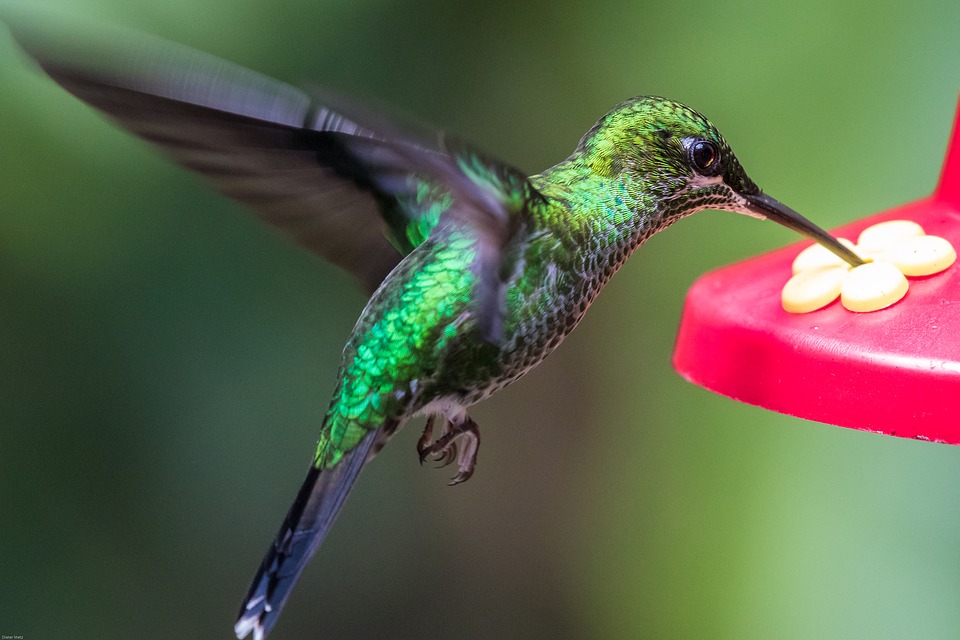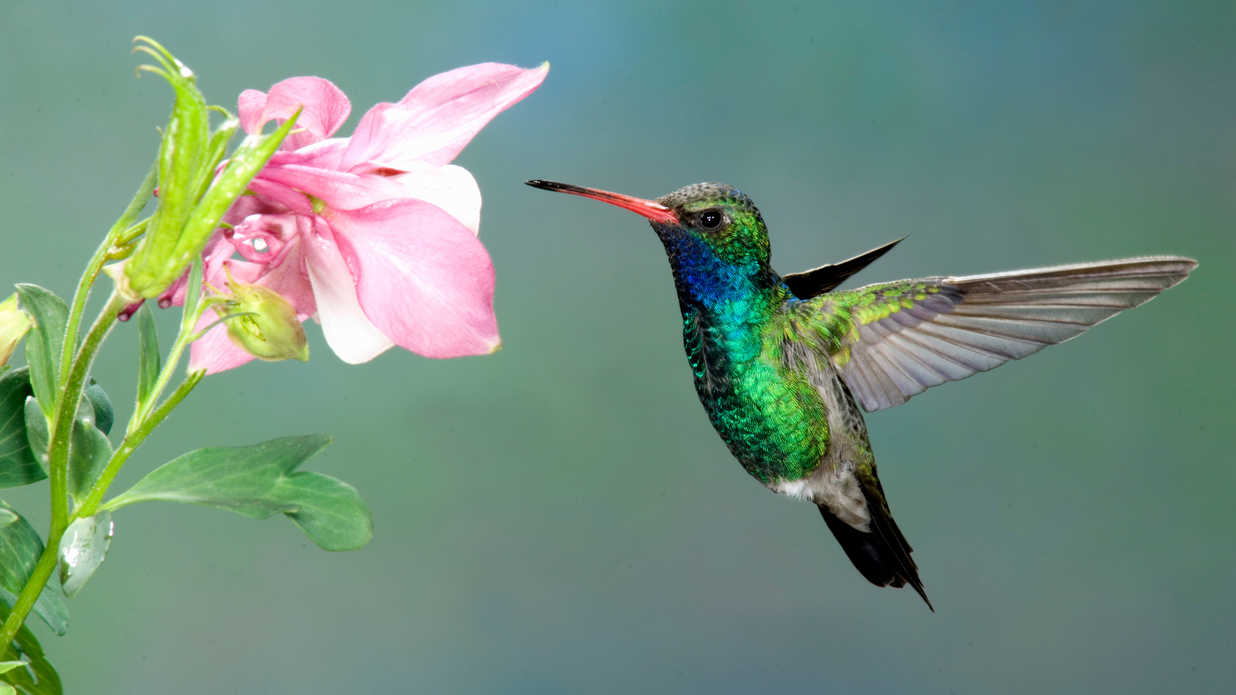All birds are fascinating creatures, but hummingbirds are some of the most interesting of the nearly 10,000 bird species in the world.
Hummingbirds are the smallest birds in the world, but they belong to one of the largest group of birds called the Trochilidae family.
They are colorful birds with iridescent feathers. Their name comes from the fact that they flap their wings so fast (about 80 times per second) that they make a humming noise. Each species creates a different humming sound, depending on the speed of its wing beats. These enchanting birds are found in deserts, mountains, and plains, but most live in tropical rainforests.
Hummingbirds can fly right, left, up, down, backwards, and even upside down. They are also able to hover by flapping their wings in a figure-8 pattern. In the Caribbean, people call the hummingbirds el zunzun.
There are 328 species of hummingbirds. The smallest is the bee hummingbird from Cuba, and the largest is the giant hummingbird from South America.
Hummingbirds come in all colors of the rainbow, and some of their feathers actually change color as they move in the light. Common names such as green-crowned comet, sapphire-vented puffleg, and ruby-throated describe the beautiful, fancy feathers of the Hummingbird.
Habitat Of The Hummingbirds

The Humming Bird | image source pixabay.com
Hummingbirds live in many types of landscapes, including temperate woodlands, mountain meadows, cloud forests, tropical rainforests, and deserts. Hummingbird habitats consistently include an abundance of flowers.
Diet Of The Hummingbirds
Even though hummingbirds are small in size, they have a large appetite.
They primarily eat flower nectar, tree sap, insects and pollen.
They have a specialized long and tapered bill that is used to obtain nectar from the center of long, tubular flowers.Their fast breathing rate, fast heartbeat and high body temperature require that they eat often. They also require an enormous amount of food each day. Hummingbirds have a long tongue which they use to lick their food at a rate of up to 13 licks per second.They can digest a fruit fly, soft insect, or spider in 10 minutes.
To get through the night without making dozens of food runs, hummingbirds go into a kind of nocturnal hibernation, lowering their body temperature and heart rate so they can get some rest.
Behavior Of The Hummingbirds
Like other birds, hummingbirds communicate via visual displays. They are very territorial and have been observed chasing each other and even larger birds such as hawks away from their territories.
Family Life Of The Hummingbirds
Male hummers use their brilliant colors to court females. It is thought that the shinier a male’s feathers are, the healthier he is. Their eyes are sensitive to ultraviolet light, so colors may appear even more vibrant to them than to human eyes.
Males and females live apart until breeding season, when a male calls to a female and shows her his beautiful feathers. Some male hummingbird species attract a female by forming a lek, which can include up to 100 males. If a female seems interested in one of the males, he may perform a flying dance for her in the air.
Once they mate, the female must build her nest and raise her young on her own.
Some Fascinating Facts About The Hummingbirds
- A hummingbird’s brilliant throat color is not caused by feather pigmentation, but rather by iridescence in the arrangement of the feathers. Light level, moisture, angle of viewing, wear and tear and other factors all influence just how bright and colorful the throat may appear.
- Hummingbirds cannot walk or hop, though their feet can be used to scoot sideways while they are perched. These birds have evolved smaller feet to be lighter for more efficient flying. They will use their feet for itching and
- The calliope hummingbird is the smallest bird species in North America and measures just 3 inches long. The bee hummingbird is the smallest hummingbird species in the world and measures 2.25 inches long. It is only found in Cuba.
- Hummingbirds have 1,000 to 1,500 feathers, the fewest number of feathers of any bird species in the world. Not only do they not need as many feathers because of their tiny size, but fewer feathers also keeps them more lightweight for easier flight.
- The average ruby-throated hummingbird weighs 3 grams. In comparison, a nickel weighs 4.5 grams. It would take more than 150 ruby-throated hummingbirds to weigh one pound.
- Roughly 25 to 30 percent of a hummingbird’s weight is in its pectoral muscles. These are the broad chest muscles principally responsible for flight.
- A hummingbird’s maximum forward flight speed is 30 miles per hour. These birds can reach up to 60 miles per hour in a dive, and hummingbirds have many adaptations for unique flight.
- Hummingbirds lay the smallest eggs of all birds. Their eggs measure less than 1/2 inch long but may represent as much as 10 percent of the mother’s weight at the time the eggs are laid. A hummingbird egg is smaller than a jelly bean!
- An average hummingbird’s heart rate is more than 1,200 beats per minute. In comparison, a human’s average heart rate is only 60 to 100 beats per minute at rest.
- At rest, a hummingbird takes an average of 250 breaths per minute. Their breathing pace will increase when they are in flight.
- Depending on the species, habitat conditions, predators and other factors, including threats to hummingbirds, the average lifespan of a wild hummingbird is 3 to 12 years.
- Hummingbirds have no sense of smell but have very keen eyesight.
- Hummingbirds do not suck nectar through their long bills, they lick it with fringed, forked tongues. Capillary action along the fringe of their tongue helps draw nectar up into their throats so they can swallow.
- Hummingbirds digest natural sucrose—the sugar found in floral nectar—in 20 minutes with 97 percent efficiency for converting the sugar into energy.
- Many hummingbird species, including Anna’s, Black-chinned, Allen’s, Costa’s, rufous, calliope and broad-tailed hummingbirds, can breed together to create hybrid species. This is one factor that makes identifying hummingbirds very challenging.
- The peak fall migration period for hummingbirds is from mid-July through August or early September, depending on the route and the exact species. Species that nest further north generally begin migration earlier.
- Hummingbirds are native species of the New World and are not found outside of the Western Hemisphere except in a few zoos or aviaries. There are no hummingbirds found in Europe, Africa, Asia, Australia or Antarctica.
About Hummingbirds
They are the smallest birds in the world. Can be found in deserts, mountains and rainforests. They are quite territorial and not very sociable. They come in all colors of the rainbow.
Article References:
- https://en.m.wikipedia.org/wiki/Hummingbird
- https://defenders.org/hummingbirds/basic-facts
- https://www.thespruce.com/fun-facts-about-hummingbirds-387106







